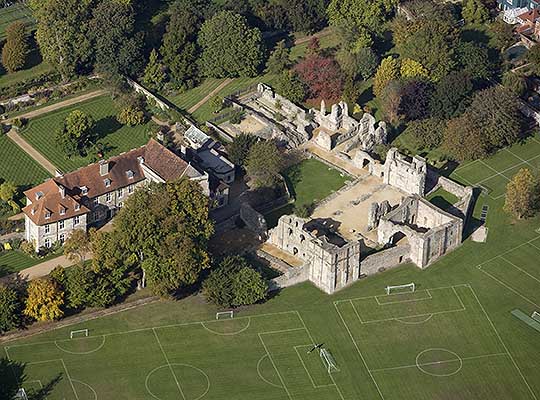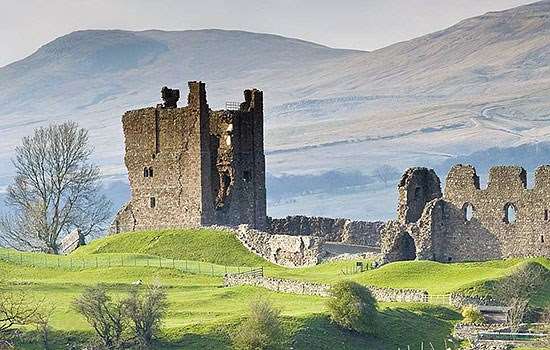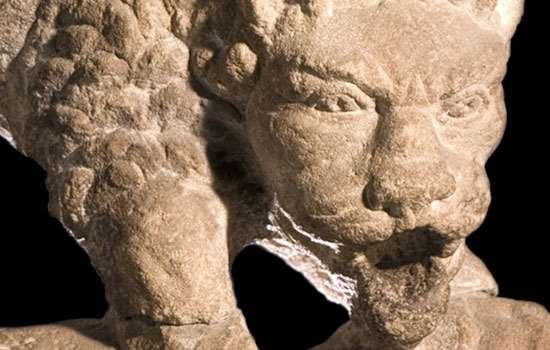History of Wolvesey Castle (Old Bishop’s Palace)
Wolvesey Castle was one of the greatest medieval buildings in England – the palace of the powerful and wealthy bishops of Winchester. One of the most important Norman palaces in England, it was built during a period when Winchester was second only to London as a royal and ecclesiastical centre. The palace remained in use until the 1680s, when Bishop George Morley decided to build a new palace nearby.

The Early Bishops of Winchester
Throughout the medieval period the bishops of Winchester held one of the highest positions of power in the English church, as well as in national politics. They owned vast estates stretching from Somerset to London, which brought them great wealth.
The Bishop of Winchester once lived as part of the community of monks who served the cathedral church. By the 10th century, however, the increasingly public role of the bishop meant that an enclosed monastery life was impractical.
Aethelwold I (963–84) was the first bishop to live separately from the cathedral. Little is known about his residence, which lay north of the present palace, but it probably included a hall, residential accommodation and a chapel.
In about 1110 Bishop William Giffard (1107–29) built the stone west hall, which is today largely buried beneath the baroque palace. However, the ruins of the northern end have survived.
Raised up on the first floor to give the building an imposing appearance, these rooms served as the bishop’s private chambers, but were also frequently occupied by royal guests.
Bishop Henry of Blois
The surviving ruins of Wolvesey were largely the creation of one man, Bishop Henry of Blois (1129–71), who built a palace befitting his immense wealth and powerful position. Appointed abbot of Glastonbury in 1126, Henry succeeded William Giffard as bishop of Winchester three years later. When his brother Stephen became king in 1135, he took on the role of the king’s chief adviser, and in 1139 became papal legate, the pope’s representative in England.
Until his death 42 years later, Henry was continually adding new buildings at Wolvesey, starting with another hall block (the ‘east hall’).
Although subsequent bishops carried out various repairs and alterations to the buildings, Henry’s palace survived virtually intact for the next 500 years. It is his work that comprises most of the ruins visible today.
Civil War and the Fortification of Wolvesey
During the civil war of King Stephen’s reign, when both Stephen and the Empress Matilda claimed the English throne, Bishop Henry was naturally at the heart of events.
In 1141, King Stephen was captured by Matilda’s forces. Henry deserted his brother, welcoming the empress to Winchester and preparing to consecrate her as queen. He was soon alienated by her attitude, however, and returned to his brother’s cause.
With the help of Stephen’s other supporters, Henry laid siege to Winchester, with Matilda trapped inside. Accounts of the siege are confusing, but Wolvesey certainly played its part. At the height of the fighting, Bishop Henry’s defenders rained down fire on the town, destroying part of the city. The empress was defeated and Stephen was restored to the throne.
Possibly because of his insecure position in the years following the siege, Bishop Henry fortified his palace, erecting two large towers. This may have been an attempt to restore his reputation as a leading figure of authority, giving his palace the appearance of a strong castle.
The Bishops and Their Diocese
Wolvesey was just one of many grand houses and castles owned by the bishops of Winchester across their diocese, which covered Hampshire, Surrey and the Isle of Wight. The bishops were constantly on the move, travelling between their estates and attending the royal court – many of them were important royal officials.
Their wealth came from vast landholdings, one of the richest estates of medieval England. The yearly income and expenditure on the estates was recorded in great detail in the pipe rolls, an astonishing surviving series of documents covering the years from 1208–9 until 1710–11.
Each year the estate manors totalled up their accounts, and sent the profit in cash directly to the treasury at Wolvesey. In the year 1301–2 this profit totalled £5,188, over £2 million in today’s money. Income was generated from land rents, sales of produce, and fees imposed at the manor courts.
Wolvesey in Decline
Wolvesey continued in declining use as an episcopal house until the 1680s, when it was abandoned in favour of a new palace built next to the medieval site by Bishop George Morley (1662–84).
By the mid-18th century the bishops preferred to use Farnham Castle in Surrey as their main residence and Wolvesey was neglected. Although the baroque palace was largely demolished in 1786, the west wing survived, and remains the current bishop’s residence.
Further Reading
Beaumont, JT, English Heritage Book of Winchester (London, 1997)
Biddle, M, Wolvesey: The Old Bishop’s Palace, Winchester (English Heritage guidebook, London, 1986)
Page, M, The Medieval Bishops of Winchester: Estate, Archive and Administration (Hampshire County Council, Winchester, 2002)
Riall, N, Henry of Blois, Bishop of Winchester: A Patron of the Twelfth Century Renaissance (Winchester, 1994)
Wareham, J, Three Palaces of the Bishops of Winchester: Wolvesey, Bishop Waltham’s Palace and Farnham Castle Keep (English Heritage guidebook, London, 2000)
FIND OUT MORE



